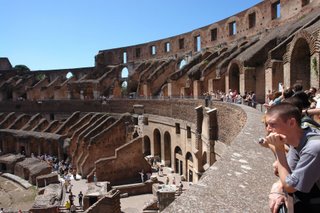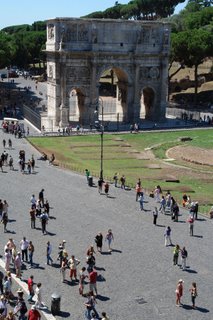



I thought I might start this account of our trip from the ending instead of the beginning. Reason is that a large part of the emotional excitement came at the end—if excitement it can truly be called.
I'm referring to the news, on the day prior to our return home from Rome, of the heightened airport security measures resulting from the discovery of a terrorist plot in Britain to blow up planes bound for the U.S.
Throughout the morning, the television in our hotel room kept up an alarming drumbeat of updates about new airport security requirements. No liquids, gels, or pastes of any kind would be allowed on carry-on luggage. Clear plastic bags would be used to carry passports and wallets on board. Anything else had to be placed in checked luggage. And calling the airline to reconfirm our flight or to seek updates required holding times of thirty minutes and more.
But later on, out there at the sweltering Colosseum the long lines of tourists waiting to get inside the famous landmark seemed remarkably nonchalant, as did the throngs sitting on every available Spanish Step in the golden glow of the late afternoon sun. Were any of these people thinking about terrorist plots or airline flight cancellations and delays? Not so far as any casual observer could tell.
Rome in August is typically empty of Romans, and filled instead with sweating sightseers from all corners of the globe. The sign 'chiuso per ferie' (closed for vacation) appears on one out of every two shops and restaurants in the Eternal City. Even His Holiness the Pope has gone off to the coolness of the Castel Gandolfo in the Alban Hills.
Rome was hot, hot, hot. But so were most of the other places we had visited during the previous ten days, starting from Civitavecchia.
Out floating hotel took us past the volcanic island of Stromboli and the Aeolian Isles, and then from the Tyrrhenian to the Ionian Sea through the Strait of Messina, past the Gulf of Taranto, and round the heel of the Italian boot into the Adriatic. By the third morning we were docked outside the ancient city of Dubrovnik, on the Dalmatian coast of Croatia.
All these seas are of course parts of the Mediterranean as any Italian schoolchild knows, and in color they share the various shades of deep blue for which this part of the world has been known from time immemorial. The "wine-dark sea" of the poets.
The Placa in Dubrovnik is just another shopping street, full of souvenir and t-shirt vendors, only more picturesque than most because of its stone achitecture and flagstone paving. Nowadays to walk along the city walls, you have to pay admission, something we had not done back in 1985 when we last visited, and when the place was still a part of the undisassembled Yugoslavia. Most of the damage from the war has been repaired, but here and there are signs of the recent conflict— a bullet hole in a marble wall, a patch on a tile roof.
In the evening, from the ship's rail, I watched the last busload of tourists return from a day-long side trip into Bosnia. Most of the weary passengers waved cheery goodbyes to the tour guide and her driver and trudged towards the gangway, but one elderly couple remained for several long minutes to have their picture taken beside the bus with the guide and driver. There were hugs and lingering farewells. It must have been, I assumed, a very memorable and edifying day for the visitors, who seemed reluctant to have it end. Then the smiling guide gave a final wave, signalled to the driver, and both boarded the bus. After the elderly couple had come aboard the ship, the gangway was pulled up. The ship then edged slowly away from the pier. And into the sunset.
Next stop on our itinerary was the Greek island of Corfu, or Kerkyra, full of the charm of its checkered past, its Venetian history, its stately mansions, and the open air cafes in the pleasant Spianada park. The sound of the cicadas filled the fragrant air with its steady hum. Tourists from the cruise ship scoured the shops, buying everything from jewelry to olive oil soap to plaster statues of Apollo. Many of our ship's passengers came from Spain, having boarded at Barcelona. Their lisping Castilian could be heard in Corfu's sidewalk cafés and coffee bars. They seemed to be quite at home here.
I had never heard of the Greek port of Katákolon until just before we left home on this trip. Now I know it as a small and pleasant village on the Ionian coast, not all that touristy just yet but slowly getting there, and the starting point for cruise line passengers up to the ancient city of Olympia. Olympia's ruins and the museum we had visited once before on a land tour, but for the kids it was exciting to see where the Olympic Games began.
To arrive in the bay (actually the volcano's caldera) of Santorini in the morning is worth getting up early to witness. The bay is too deep for the ship to drop anchor, so it just sort of casually sits there in the middle, while a fleet of tenders come out from the base of the cliff to ferry passengers ashore. Then there's a funicular ride, or else a donkey ride, up the face of mountain to the volcano's rim and the town of Fira, from where you can take some of those spectacular photos that might end up on travel brochures and calendars — white cubist houses and blue church domes, and a sea of such beauty that one cares not to remember that it was created millenia ago by one of the mightiest cataclysms in that part of the world.
In the town itself we find the mandatory souvenir shops, and some excellent restaurants, along the narrow pedestrian streets. But farther away from the center the buzzing scooters, all-terrain vehicles, and cars, coupled with the traffic cop's shrill brass whistle, all combine with the crowds in the streets to produce noise pollution of Olympian proportions on an otherwise placid Aegean island.
The next morning we arrived in Kusadasi, Turkey, the jumping off point for a visit to the fabulous Roman ruins of Ephesus.
Well, now, let's save the rest of this travel diary for another day.

No comments:
Post a Comment